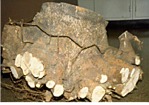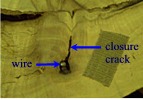Home > Root growth > Root growth and wire baskets
Root growth and wire baskets
(Click on photographs for more information-suggest starting with 1)
1 plastic burlap girdling |
2 plastic burlap not recommended |
3 tree ungulfing wire basket |
4 root growing around wire |
Baskets made from heavy gauge wire are often used to help hold a B&B root ball intact during shipping and handling. Wire also allows for the tree to be picked up by the root ball instead of the trunk. This is a very effective means of ensuring that roots inside the root ball remain intact with soil. Wire in baskets degrades slowly in soil, and can be intact 20 years after planting. However the welds typically degrade sooner. There is no research documenting the detrimental effects of wire baskets on trees. In fact, some research shows that roots engulf the wire (see above photo) with little apparent harm to the tree (Lumis 1990; Watson 1994). Strapping and non-biodegradable string can be left on the tree along with the basket as long as someone returns to remove strapping and string a year later. If root flare is too deep in the root ball so proper planting sets the wire above grade then the wire above grade should be removed.
Some horticulturists recommend removing at least the top 12 to 18 inches (two or three levels) of wire from the root ball, or the entire basket. One to several minutes are required to remove the wire basket. Trees with the wire basket removed at planting often require staking, especially if the root ball is sandy, or the root system is not well established or is loose in the ball.
To remove the top portion of the basket, the top of the planting hole will have to be dug wider than the root ball. This extra hand digging creates the clearance needed to cut and remove the wire all around the root ball after it is installed in the planting hole.
 To
remove the entire wire basket at planting, first cut away the bottom half of the basket
leaving the top half intact. Place the tree into the planting hole and fill
in around the root ball with enough soil to stabilize the tree. Remove the top
half of the basket and backfill to complete the planting job. After removing
the lower portion of the wire basket, clayey or loamy root balls usually stay
intact. Root balls with inadequate root systems, or those with very sandy soils
may loose soil from the bottom of the ball when the tree is picked up and lowered
into the planting hole. The
tree is likely to shock and could die. Again, the tree will need to be staked when the basket is removed. Of course the staking will need to be removed about a year later.
To
remove the entire wire basket at planting, first cut away the bottom half of the basket
leaving the top half intact. Place the tree into the planting hole and fill
in around the root ball with enough soil to stabilize the tree. Remove the top
half of the basket and backfill to complete the planting job. After removing
the lower portion of the wire basket, clayey or loamy root balls usually stay
intact. Root balls with inadequate root systems, or those with very sandy soils
may loose soil from the bottom of the ball when the tree is picked up and lowered
into the planting hole. The
tree is likely to shock and could die. Again, the tree will need to be staked when the basket is removed. Of course the staking will need to be removed about a year later.
If you are inclined to remove the top portion of the basket then consider doing so about one year after planting when roots have stabilized the tree. In either case (removing the basket at planting and staking vs. leaving the strapping and basket intact at planting and not staking) just like a tree planted from a container, a return trip is required about a year after planting to remove something from the tree. On balance, it sounds like you are better off leaving the basket intact at planting and planning on returning in a year to remove the top portion.





